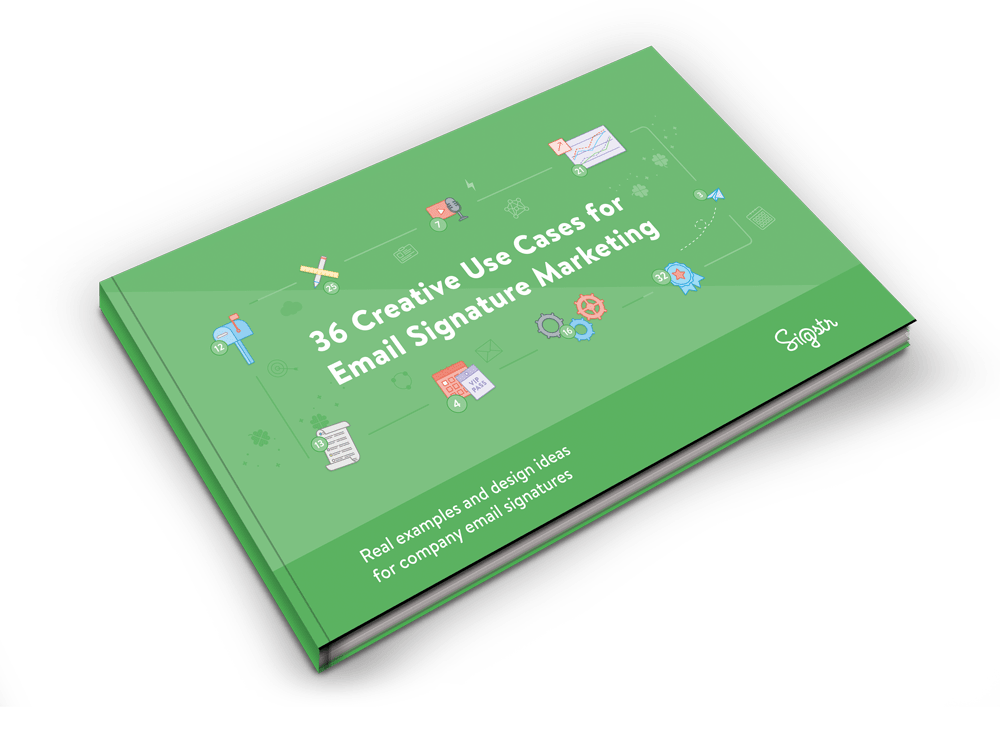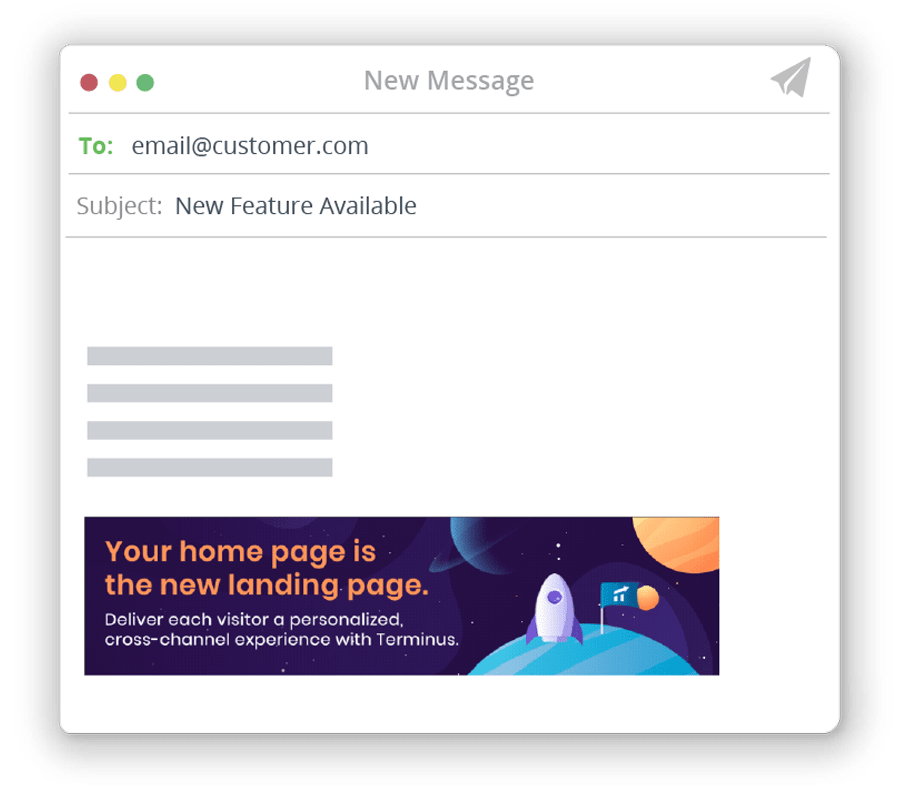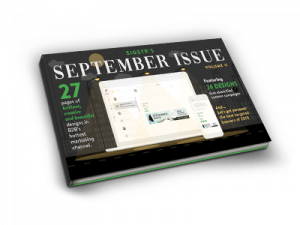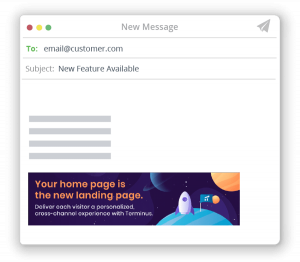How to End an Email Professionally: Branded Email Signatures
Standardize your company email signature across all employees and turn it into your new favorite marketing channel. Request a demo today or check out 36 different customer examples.


The Leading Email Signature Solution (and Much More!)
Our 1,000+ customers use Terminus to easily add and manage email signatures across their entire company. Not only that, Terminus also provides teams all of the channels and data they need to get in front of their most important prospects and customers.

[Ebook] The Total Marketing Impact of Professional Employee Email
Read it now
Terminus September Issue: The Best Email Banner & Digital Ad Designs
learn more
[Blog] 6 Examples of Using Employee Email as a New Marketing Channel
See more examplesHow to End an Email Professionally
How to end an email professionally depends on your closing paragraph and sentence, the sign off, and the email signature (Sigstr knows a lot about that last point). Each element builds up to form the last impression you are wanting to leave on your reader, and we know you are wanting to make it a good one. Not only does the ending of an email leave a reader with a lasting impression, but it also represents who you are and your professionalism.
To truly write a professional email, you need to include all of these points above, as one is just as important as the other. If you have a great email closing sentence but an average sign off, the reader could only remember the last thing they read and forget about your awesome content. Email closing remarks let you summarize what you believe is most important in your email in a creative and slick way. Here at Sigstr, we help you bring creativity to your email by adding a customized email signature and banner to the end of your email. This “ad” allows you to promote your most important initiatives specific to certain audiences, while also providing additional professionalism to your email. But before the banner, it’s important to focus on your sign off and email signature. Using a sign off instead of jumping straight to your signature shows your readers that you appreciate the time it took to read your email, while also giving them courtesy. The sign off of an email is just as effective as the greeting. If you were to launch right into your content with no greeting to your readers, you lose a part of the relationship you have or you’re trying to build. Adding greetings and sign offs to your emails are key aspects that help make your email professional. Ending an email sounds simple, and these tips will help you end your email more strongly, respectfully, and with added professionalism.
Best Email Sign Off
The best email sign off is impossible to rank, but there are different types of sign offs that are making their way to the top as some of the best and most memorable. Your sign off and signature represent digital real estate you can utilize for your personal branding. Depending on how in depth you are wanting to be with your signature, there are a few do’s and don’ts you should follow. You should, at a minimum, include your name, title of your position, and contact information in some form (phone number, email address, business website). If you want to add more, you can add social media links, a logo, or a professional photo. Each section of a signature gives you the opportunity to show off your brand and what you want others to know about you.
Additionally, sign offs can vary depending on how the email is established and who it is addressed to. For example, if you are asking a colleague for a favor, your sign off could be “Thanks in advance”, or if you want to add a relational aspect to your email you can finish with “Hope you are having a great week” or “Looking forward to hearing from you”. How to end an email to a company is a little different as you should be more professional with your sign off. Some examples of a professional sign off include “Best regards”, “Respectfully”, or “Yours truly”. These phrases that lead into a professional signature and banner will help represent yourself in a good light. Most overlook the importance of a signoff, signature, and banner when they create their emails as they believe the content is the most important component. We hope our points above will help you realize a stellar sign off and signature is just as important as the content in your email.
How to End an Email to a Professor
Even if you are still a student, it is important to represent yourself professionally when you write an email. How to end an email to a professor is similar to ending a business email as you should act professionally, but different as you are usually asking a professor for help. Same situation with how to end an email to a teacher because you should treat your email to your teacher as if you are writing an email to your boss. You can glance at a how to write an email to a teacher sample to get extra tips of the do’s and don’ts. There are several situations to guide you with what format to use when emailing a professional in the education space. How to write an email to a professor about grades is formatted differently than how to write email to submit assignment, how to email a professor about missing class, or an email to professor for phd position. When asking a teacher or professor for help with grades or an assignment, a student should be more respectful and professional than when a student is emailing an assignment to submit. How to email a teacher about an assignment must be written after you have done all the research you can and are still unable to find an answer. The email should also be written in a respectful manner because you are asking your professor or teacher for help. Make sure to always introduce yourself and what class time or section you are in, as it will help the professor remember you and what assignment you are talking about. Some professors teach several classes at different times, and it is courteous of you to give them background on you and the assignment. Various resources give you a selection of samples to choose from such as a sample email to professor asking for help, sample email to professor asking for appointment, or a sample email assignment to teacher.
We want to provide you with multiple tips for writing emails so you don’t end up writing unprofessional emails to professors. Not only do professors usually lose some respect for someone who writes an unprofessional email, but some may not respond to your email at all. This could cost you the answer to an important question you had about a test or project. Taking a little extra time to proofread your email will go a long way. As a student, you will soon be entering the world of daily email interactions, so just take a little extra time now to perfect your email skills and you will thank us later.
Professional Email Closings
Professional email closings are different for every person and every email situation. As we already discussed earlier the importance of a professional sign off and signature, we now want to focus specifically on the final paragraph. Not only is this the last place for you to emphasize the importance of the contents in your email, but it is also the last paragraph that your reader will remember reading. How to end a formal email depends on the circumstances, whether you are writing to ask for a job, addressing the whole company, thanking a customer for their business, or delivering some bad news; each will have a different format and guidance on how to write your final paragraph. In any last paragraph you write, you should summarize why you emailed them, thank them for taking the time to read your email, and then end with a call-to-action. This CTA can be as simple as your reader just replying that they received your email or it can be a task for them to complete. The format you choose for your closing paragraph will help narrow down your options from the formal letter ending phrases to sign off with. The closing sentence in business letter is your last chance to leave a good impression on your reader, while also reiterating the importance of your email. You should always have a section of your closing for email closing lines thank you, as this shows politeness on your end. Below we have provided some guidance for how to end an email in some of the most common situations.
How to end an email for a job should be respectful and brief. You should re-emphasize why you want the job and why you are fit for the position, but also add gratitude for them considering you and taking the time to read your email. Similarly, how to end an email for a job interview should explain why you want the position and your qualifications, but also with respect and gratitude towards your potential future employer. Your call-to-action for both a job and interview should be along the lines of “Look forward to hearing from you soon”, while also providing your contact information. How to end a difficult email depends on specific circumstances, but you should always try to end with goodwill; whether it is with politeness, thanking them for their previous work, or providing your contact information if they have any questions. Email endings represent an important component of emails that are usually overlooked, but we hope our advice will help you gain a skill for years to come.
Personal Letter Closings
For personal letter closings, you have the opportunity to be informal but it is still important to be thoughtful about your closing paragraph, sign off, and email signature. If you send a thoughtful email to someone you are close with and end with “Best regards” or “Yours Truly”, they will feel the sign off was too professional and might be awkward. How to end a friendly letter can instead be with closings such as “Cheers”, “Many thanks”, or “Warmly”. When writing an email to a friend, depending on your closeness with them, you can be informal or semi-formal. These closings allow you to focus on the relationship you have with the reader instead of the professionalism aspect.
How to end an informal letter is just like how to end an informal email, as you will not focus as much on the sign-off or signature in these situations. For informal letters or emails, the reader is focusing more on what you have to say versus your professional sign-off and signature. With personal letters, you also are given the chance to personalize your closing paragraph and sign off. Instead of summarizing what you previously mentioned above, you could plan a time to meet up with the reader soon, ask how they are doing, or send them goodwill. Personal letters give you more freedom for what you want to say, how you want to say it, and how you can format it. It is still important to follow the guidelines of a proper email, but personal emails are unique to you and your reader. Sigstr is here to help you learn the difference between How to end an email to a friend compared to how to end an email to a boss, but also learn the importance of each and when to use both closings.



